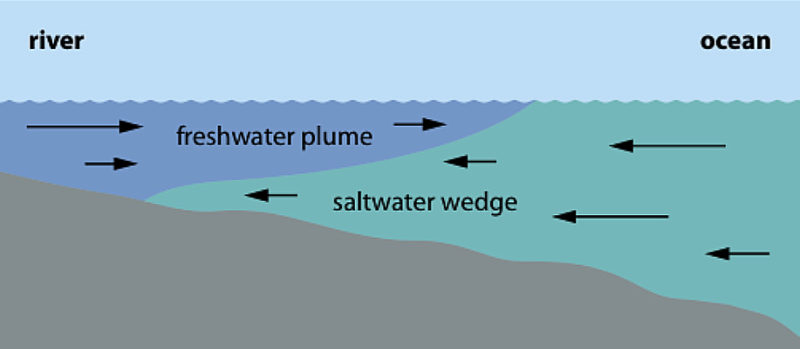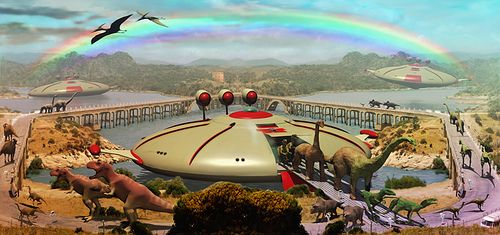It looks like you're using an Ad Blocker.
Please white-list or disable AboveTopSecret.com in your ad-blocking tool.
Thank you.
Some features of ATS will be disabled while you continue to use an ad-blocker.
share:
originally posted by: Degradation33
Is the liquid ringwoodite down there with all the liquid diamonds?
There are layers closer to the surface where solid minerals exist, but deep in the mantle it is so hot and pressurized that it liquefies minerals. This is what magma is, this shouldn't be too hard to picture. Water vapor also emerges from volcanoes, further verifying the presence of deep underground water.
a reply to: cooperton
And still no answer as to why pitch was around before the flood caused all the oil deposits???
And still no answer as to why pitch was around before the flood caused all the oil deposits???
God told the patriarch to coat the ark, both inside and out, all 229,500 square feet of it, with pitch, and, in fact, this was a common practice in ancient times. But when Noah hurried to the corner hardware store, the shelf was bare, for pitch is a naturally occurring hydrocarbon similar to petroleum (Rosenfeld, p. 126), and we know that oil, tar, and coal deposits were formed when organic matter was buried and subjected to extreme pressure during the flood
originally posted by: Kurokage
but the supercritical fluid can't excist can it? It's caused by tectonic plate movement which you say doesn't happen, I see you choose to ignore this...
1) I never said tectonic plates don't exist, I just said the flood is responsible for marine fossils on top of everest rather than tectonic plates moving it up so high.
2) it's not supercritical due to tectonic plates, it's the hot core and the pressure above it that causes water to become a supercritical fluid
Also any water is part of the structure of wadsleyite and ringwoodite in this layer of the crust, and not a supercritical fluid.
No you're referring to the solidified samples we find when they're spewed to earth's surface. In the mantle the heat and pressure would liquefy these minerals (i.e. magma)
edit on 24-12-2023 by cooperton because: (no reason given)
originally posted by: Phantom42338
What about all the species in the sea, including megalodon? Noah must have built one hell of an aquarium.
Gee phantom I think they would be fine since the world was one big ocean after the flood lolol.
More memes to come when I get to my laptop
originally posted by: Phantom42338
BTW, what about the fresh water fish and semi aquatic animals? Did Noah have a desalination plant on board?
This was brought up earlier and there was no answer actually given.
One way would be to use the rainwater to turn over the water in the ark's aquarium but another thing not answered, which is why we don't take these types of people seriously is, how did the fresh water fish get to the ark?
And who was the sushi chef?
It was Samael, known by many names, including the seducer, he had much experience with the varieties of raw fish flavors.
a reply to: cooperton
So you're saying and agreeing that Everest was created due to tectonic movement, but any fossils was due to the flood?
The water you're trying to imply caused the flood is there due to tectonic movement. anything else is locked up in diamond type crystal structure called wadsleyite and ringwoodite that have already showed your wrong.
And again I also see you're still ignoring this, that proves your entire premise wrong...
I never said tectonic plates don't exist, I just said the flood is responsible for marine fossils on top of everest rather than tectonic plates moving it up so high.
So you're saying and agreeing that Everest was created due to tectonic movement, but any fossils was due to the flood?
it's not supercritical due to tectonic plates, it's the hot core and the pressure above it that causes water to become a supercritical fluid
The water you're trying to imply caused the flood is there due to tectonic movement. anything else is locked up in diamond type crystal structure called wadsleyite and ringwoodite that have already showed your wrong.
And again I also see you're still ignoring this, that proves your entire premise wrong...
God told the patriarch to coat the ark, both inside and out, all 229,500 square feet of it, with pitch, and, in fact, this was a common practice in ancient times. But when Noah hurried to the corner hardware store, the shelf was bare, for pitch is a naturally occurring hydrocarbon similar to petroleum (Rosenfeld, p. 126), and we know that oil, tar, and coal deposits were formed when organic matter was buried and subjected to extreme pressure during the flood
edit on 24-12-2023 by Kurokage because: (no reason given)
originally posted by: Kurokage
The water you're trying to imply caused the flood is there due to tectonic movement. anything else is locked up in diamond type crystal structure called wadsleyite and ringwoodite that have already showed your wrong.
It would not be in solid crystal form if the mantle is hotter than it's melting point.
originally posted by: Phantom42338
BTW, what about the fresh water fish and semi aquatic animals? Did Noah have a desalination plant on board?

Fresh water is less dense and salty water so it would be towards the surface, whereas it would be salty at deeper depths.
youtu.be...
This shows how salty and fresh water can layer. The persistent rain from above would be freshwater, creating a freshwater layer at the top of the ocean.
Semi-aquatic animals, from what I've read, can survive without swimming in water. It's not as though being in water is required for them to survive like with fish.
edit on 24-12-2023 by cooperton because: (no reason given)
originally posted by: Kurokage
And again I also see you're still ignoring the need for pitch, that proves your entire premise wrong...
"God told the patriarch to coat the ark, both inside and out, all 229,500 square feet of it, with pitch, and, in fact, this was a common practice in ancient times. But when Noah hurried to the corner hardware store, the shelf was bare, for pitch is a naturally occurring hydrocarbon similar to petroleum (Rosenfeld, p. 126), and we know that oil, tar, and coal deposits were formed when organic matter was buried and subjected to extreme pressure during the flood
There's more forms of pitch than just petroleum-based. There's also resin-based pitch which is plant derived.
a reply to: cooperton
That only happens at points where freshwater rivers flow into the ocean.
See where it says freshwater plume? That is the flow of the river creating that boundary but it does mix with the saltwater and rather quickly. There is no freshwater layer on top of the oceans.
Since I'm here, who cares how much water is in the crust, nobody has ever seen it just pop up and flood the whole earth. It just means there is a bunch down there.
ETA: As for the vid:
The salt in the water makes the dye float but that doesn't mean that top layer isn't salty.
That only happens at points where freshwater rivers flow into the ocean.
See where it says freshwater plume? That is the flow of the river creating that boundary but it does mix with the saltwater and rather quickly. There is no freshwater layer on top of the oceans.
Since I'm here, who cares how much water is in the crust, nobody has ever seen it just pop up and flood the whole earth. It just means there is a bunch down there.
ETA: As for the vid:
The salt in the water makes the dye float but that doesn't mean that top layer isn't salty.
edit on 24-12-2023 by daskakik because: (no reason
given)
originally posted by: cooperton
originally posted by: Phantom42338
BTW, what about the fresh water fish and semi aquatic animals? Did Noah have a desalination plant on board?
Fresh water is less dense and salty water so it would be towards the surface, whereas it would be salty at deeper depths.
youtu.be...
This shows how salty and fresh water can layer. The persistent rain from above would be freshwater, creating a freshwater layer at the top of the ocean.
Semi-aquatic animals, from what I've read, can survive without swimming in water. It's not as though being in water is required for them to survive like with fish.
By your logic I could take a 5 gallon bucket of freshwater and toss it in the ocean and it would just float on top and remain freshwater .
originally posted by: Ravenwatcher
By your logic I could take a 5 gallon bucket of freshwater and toss it in the ocean and it would just float on top and remain freshwater .
With consistent rain water for 40 days and 40 nights it could have made a similar effect to a freshwater river entering the ocean.
originally posted by: Phantom42338
a reply to: cooperton
You don't have a clue.
Phantom you asked where a saltwater fish would have went during the flood lol.
edit on 25-12-2023 by cooperton because: (no reason
given)
originally posted by: cooperton
With consistent rain water for 40 days and 40 nights it could have made a similar effect to a freshwater river entering the ocean.
Maybe, but it would have been a very thin and short lived layer. Once the rain stopped there were 150 days with nowhere for the freshwater fish to survive.
originally posted by: Phantom42338
Phantom you asked where a saltwater fish would have went during the flood lol.
The dilution of the salt concentration in the water would have affected the salt water fish as well. It is a legit question.
originally posted by: daskakik
Maybe, but it would have been a very thin and short lived layer. Once the rain stopped there were 150 days with nowhere for the freshwater fish to survive.
I think if the sea level were raised to the height of everest that the ocean streams and tides would be remarkably different, meaning the potential for less mixing of the varying densities of waters (which is part of the reason ocean salinity stays relatively homogenous). Even so there are stark differences in ocean salinity based on latitude and other factors, as well as freshwater fish that can survive high salinity conditions.
The dilution of the salt concentration in the water would have affected the salt water fish as well. It is a legit question.
I was looking at hurricane changes to Salt levels and it does change the surface but towards the bottom the salinity remains the same because the denser saltier water tends to sink
a reply to: cooperton
You talk about water venting from the crust, that would be like a jacuzzi, even on low.
Stoichiometry causes even distribution, any agitation, falling water, sea currents would just speed that up.
A small percentage of fresh water fish being able survive doesn't mean that most aren't going to die.
That is what I dislike about your answers, "but these 1,000,000 fish would make it so the story must be real" is still a real stretch.
You also have not taken into account the temps at that altitude.
The story just doesn't work.
You talk about water venting from the crust, that would be like a jacuzzi, even on low.
Stoichiometry causes even distribution, any agitation, falling water, sea currents would just speed that up.
A small percentage of fresh water fish being able survive doesn't mean that most aren't going to die.
That is what I dislike about your answers, "but these 1,000,000 fish would make it so the story must be real" is still a real stretch.
You also have not taken into account the temps at that altitude.
The story just doesn't work.
edit on 25-12-2023 by daskakik because: (no reason given)
originally posted by: daskakik
originally posted by: cooperton
With consistent rain water for 40 days and 40 nights it could have made a similar effect to a freshwater river entering the ocean.
Maybe, but it would have been a very thin and short lived layer. Once the rain stopped there were 150 days with nowhere for the freshwater fish to survive.
originally posted by: Phantom42338
Phantom you asked where a saltwater fish would have went during the flood lol.
The dilution of the salt concentration in the water would have affected the salt water fish as well. It is a legit question.
It's a miracle then.
Somehow the Creator of heaven and earth and all living things did not feel He had to entrust all marine life as He must have been able to provide for them.
Noah was only charged to collect and provide for air breeding animals.
No accommodations required by Noah to provide for salt water or fresh water fish.
I guess it is a miracle God provided for marine life during a flood.
Amazin
new topics
-
Swedish Minister for Gender Equality is Seeking Treatment for Phobia of Bananas
Other Current Events: 9 hours ago -
Satanic ‘Little Season’ of Deception.. Awaken to the Handiwork of the Creator.
ATS Skunk Works: 9 hours ago -
USA-BIDEN and CHINA-Xi Agree Not To Let Artificial Intelligence Decide Nuclear Weapons Use.
World War Three: 9 hours ago
top topics
-
The mysterious death of Aileen Conway
General Chit Chat: 12 hours ago, 6 flags -
Swedish Minister for Gender Equality is Seeking Treatment for Phobia of Bananas
Other Current Events: 9 hours ago, 5 flags -
USA-BIDEN and CHINA-Xi Agree Not To Let Artificial Intelligence Decide Nuclear Weapons Use.
World War Three: 9 hours ago, 3 flags -
Satanic ‘Little Season’ of Deception.. Awaken to the Handiwork of the Creator.
ATS Skunk Works: 9 hours ago, 3 flags -
Half-Life 2 is 20 Years Old - its Also Free on Steam until the 18th
Video Games: 17 hours ago, 1 flags
active topics
-
The mysterious death of Aileen Conway
General Chit Chat • 11 • : Shoshanna -
I’m Looking for Information on the Light We See at Death.
The Gray Area • 64 • : Hecate666 -
How can you defend yourself when the police will not tell you what you did?
Posse Comitatus • 91 • : angelchemuel -
Russia Ukraine Update Thread - part 3
World War Three • 6815 • : Freeborn -
Satanic ‘Little Season’ of Deception.. Awaken to the Handiwork of the Creator.
ATS Skunk Works • 5 • : Athetos -
Swedish Minister for Gender Equality is Seeking Treatment for Phobia of Bananas
Other Current Events • 3 • : Athetos -
Bucks County commissioners vote to count illegal ballots in Pennsylvania recount
2024 Elections • 22 • : Enduro -
The JAN 6th 2021 U.S. Capitol Unrest Charges Against Former President TRUMP Were Dropped Today.
US Political Madness • 13 • : WeMustCare -
President-elect TRUMP Picks MATT GAETZ for his ATTORNEY GENERAL - High Level PANIC Ensues.
2024 Elections • 93 • : EyeoftheHurricane -
On Nov. 5th 2024 - AMERICANS Prevented the Complete Destruction of America from Within.
2024 Elections • 157 • : WeMustCare


